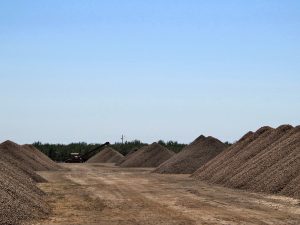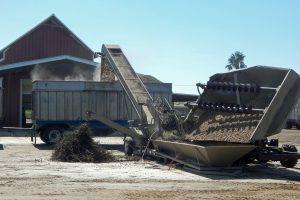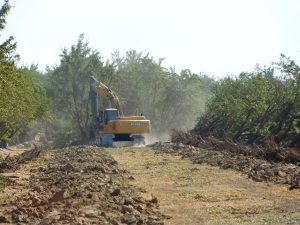
Director, Member Relations
This report covers conditions and observations made between Monday, September 3 and Sunday, October 2, 2016.
North – Clear, bright skies dominated the weather during September in the Sacramento Valley, providing for one of the quickest harvests in memory. Daily maximum temperatures exhibited a persistent pattern, varying on a ten-day oscillation between the mid 70’s and upper 90’s. Morning lows followed a similar pattern, running between the lower 50’s and lower 60’s throughout the period. In contrast to the dry conditions in September, the first days of October were accompanied by the approach of a fairly potent weather system that brought light showers to many areas of the region and heavy downpours to a few locations on the final day of the period. While the majority of the region escaped significant rainfall, a few locations in the extreme north end of the region, as well as just north and east of Sacramento reported receiving as much as a quarter inch of rain, along with some hail.
Harvest operations in the Sacramento Valley’s orchards are winding down as growers work to bring in the last of the pollenizer varieties. This year’s harvest has progressed at a very rapid pace, allowing growers to move quickly through their orchards. Observers are reporting that many growers have completed the harvest and that with few exceptions, all that remains to be harvested are the last few plantings of late maturing Monterey and Fritz. While the impact on harvesting these last orchards as a result of the rain received on the last day of the period is yet to be determined, significant issues are not anticipated. As deliveries from the orchards have slowed, huller/sheller operations with previously stockpiled almonds have already begun retrieving product, a process that will take from two to six weeks to complete.
Growers are reporting that the reduced yields experienced in the Nonpareil have unfortunately carried through to virtually all of the pollenizer varieties. Many orchards are running 20% below last year’s levels. Fortunately, quality levels are running higher than in 2015. Navel Orange Worm damage plagued many growers last year. But, wetter conditions during the past winter provided growers with better opportunities to reduce the population of over-wintering larvae, providing lower damage levels in the current crop.
Observers are reporting that the leaf-loss reported last month has increased during the harvest as the effects of Scab and Rust continued to spread and mite populations increased. While many orchards are exhibiting some degree of defoliation, observers have reported that the region’s orchards are in generally good condition.
Growers are now moving to post-harvest activities, with many focused immediately on fertilizer applications and post-harvest irrigation’s. Over the coming weeks, pruning and the removal of older, low producing orchards will also begin.
Central – While clear, bright skies covered the central region during nearly all of the period, temperatures in the northern San Joaquin Valley took on a cyclical nature during the transition from summer into fall. Daily maximum temperatures varied on a ten-day cycle, ranging from mid and upper 70’s to upper 90’s with coolest readings reported in the closing days of the period as a fairly potent weather system approached the state. Meanwhile, morning lows exhibited a bit more stability, with readings reported between the mid 50’s and lower 60’s. Conditions took a fairly dramatic turn on the final day of the period as clouds approached the region, bringing the threat of showers. While clouds moved over the northern areas of the region late in the day, only trace amounts of rain were reported.
Harvest operations continued at a brisk pace during September as growers moved from the Nonpareil into their respective pollenizer varieties. As noted in previous reports, advanced maturity of the crop, coupled with excellent weather during the month has allowed growers to move very quickly through their orchards. As a result, as this report is being prepared, most growers have completed their harvest and have moved on to post harvest tasks. However, growers with Fritz and Monterey, the traditionally last to harvest varieties are still working the fields, with a number of orchards still waiting to be shaken. With the rapid harvest, huller/sheller operations have been operating around-the-clock. Observers are reporting that much of the crop has been directed to stockpiles, which will be processed after all field operations have been completed.
Many growers are reporting that yields of the Butte and Padre varieties have been running below last year’s level. However, production yields of the Carmel and the California types, such as Price and much of the Fritz harvest so far have been reported above 2015 levels. Growers with Aldrich are reporting more variable yields, with some above and others below last year’s production.
As may be seen in the photo accompanying this report, growers who have completed the harvest have begun pruning and shredders have already started moving through the orchards. Piles of gypsum, calcium sulfate, can be found throughout the region as growers work to correct soil issues. Irrigation districts drawing water from Sierra Nevada reservoirs are making water available through much of the coming month, allowing growers to complete critical post-harvest irrigation’s needed to support flower bud formation for the 2017 crop.
Observers are reporting that the majority of orchards are in good condition. However, some problems do exist. Web-spinning mites have caused nearly total leaf loss in the most severe infestations across the region. Additionally, orchards along the west side of the region dependent on ground water have also been defoliating as the effects of poor quality water continues to impact tree growth. While the past winter’s rainfall helped to improve soil conditions in the most severely impacted orchards, the continued use of poor quality water, in many cases grower’s only supply, has negated the gains achieved. In the most severely impacted plantings, as new leaves emerge, energy and nutrients needed for the 2017 crop are being expended now, with potentially detrimental impact on the next crop.
South – Clear skies covered the southern San Joaquin Valley, excepting days when smoke from fires in the surrounding mountains moved over the valley. Temperatures followed a reoccurring pattern during September, as the southern region transitioned into fall. Both the daily high and the overnight lows varied on a ten-day pattern, with the maximum readings dipping to the mid and upper 70’s, then rising slowly to peak in the mid and upper 90’s. Morning lows followed the same pattern, ranging between the low to mid 50’s and low to mid 60’s.
Harvest operations in the southern San Joaquin Valley are entering their final stages. As noted in last month’s report, growers moved quickly through their Nonpareil plantings and in many cases immediately shook their respective pollinizers. The accelerated maturity observed in the Nonpareil this year has also provided for a rapid harvest of the pollinizers and as the period concludes, observers have reported that most growers have completed their harvest. With few exceptions, only Fritz and Monterey remain to be harvested and observers are reporting that all harvest operations in the orchards should be completed by mid-October, barring any adverse weather. With the rapid pace of harvest, much of the crop has been diverted to stockpiles found throughout the region, both at sheller facilities and on lands adjacent to the orchards where the crop was produced.
Yields in the southern San Joaquin have generally been reported at levels above those experienced in 2015. Quality levels are also generally running higher than a year ago, with reject levels caused by Navel Orange Worm and ants slightly below last year’s levels.
As growers finish the harvest, post-harvest activities move to the forefront. Re-leveling orchard floors, applying fertilizer and soil amendments and critical post-harvest irrigation’s have become normal tasks. Growers have also begun pruning and shredding brush, operations that will continue into the winter. As shown in the photo accompanying this report, heavy equipment can also be found pulling trees in orchards scheduled for removal. After the trees have been pulled, large chippers are brought in to reduce the trees to finger-sized chips. These chips have historically been trucked to “co-gen” facilities where the biomass is used to generate electricity. However, in recent years, utility companies have opted to produce electricity using natural gas at lower costs. As co-gen facilities have been forced to shut down, this has driven the cost of orchard removal much higher, with prices now quoted in excess of $750 per acre. Regulations do not allow for open air burning of the trees, forcing growers to incur very high costs to remove old, low producing orchards.


